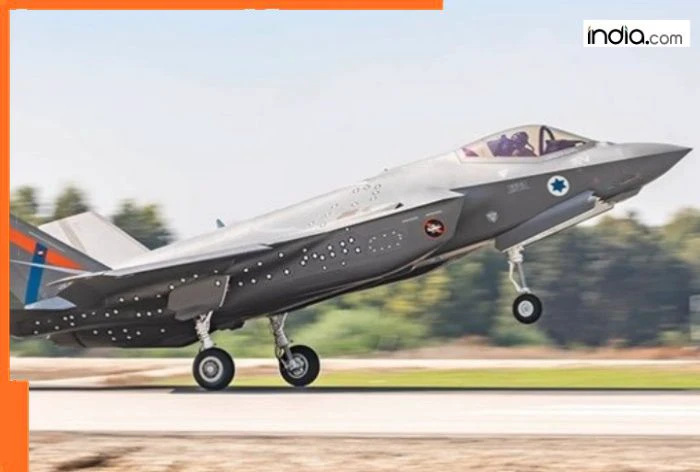Tensions between Israel and Iran grew much worse after June 13, 2025, when Israel started a major military attack called “Operation Rising Lion.” This attack showed just how strong and advanced Israel’s military really is.
Israel hit Iran’s nuclear plants, army bases, and even top leaders. More than 400 people died in these attacks. Iran tried to fight back with missiles and drones, but its response was weak. Now, let’s look at five such weapons that helped Israel carry out these attacks and hit important targets in cities like Tehran.
1. F-35I ‘Adir’ Stealth Fighter Jet
One of Israel’s strongest weapons is the F-35I Adir jet. It is a stealth jet, which means it can fly without being seen on enemy radar. Some key features:
- It can fly 2,200 kilometers without needing to refuel.
- It can go up to Mach 1.6 speed (that’s 1.6 times the speed of sound).
- It can carry up to 8,160 kg of bombs and missiles.
- It uses smart Israeli bombs called Spice precision-guided bombs.
During the operation, more than 200 F-35I jets attacked over 100 important targets in Iran, including the Natanz and Fordow nuclear plants. Because of its stealth, Iran’s air defense systems could not detect them.
The jets were able to destroy underground buildings, military command rooms, and other key sites in Iran. Thanks to the F-35I’s advanced technology, Israel gained full air control over Tehran, attacking major targets without much risk to its own forces.
Israel also used some very smart and powerful weapons in its attack on Iran. Two of these were the GBU-39/B Small Diameter Bomb (SDB) and the Jericho-3 ballistic missile.
2. GBU-39/B Small Diameter Bomb (SDB)
This is a very smart bomb that weighs around 250 pounds. Even though it is small in size, it is very powerful and can hit targets up to 110 kilometers away. It uses GPS and internal navigation to reach its target with great accuracy. One amazing thing about this bomb is that it can break through up to 3 feet of reinforced concrete. Because it is small, fighter jets like the F-16 and F-35 can carry many of these bombs at once.
During the attacks in June 2025, these bombs were used to hit:
- Missile launchers
- Nuclear research centers
- Command centers
3. Jericho-3 Ballistic Missile
The Jericho-3 is a long-range missile made by Israel. It can travel between 4,800 to 6,500 kilometers, and carry a payload of up to 1,300 kilograms. This missile can be loaded with normal or even nuclear warheads (Israel is believed to have around 90 nuclear weapons).
It uses a guidance system to find its way to the target and may also have GPS help.
Although it’s not clear if this missile was used in the June 2025 attack, its long range makes it possible to hit Tehran, Isfahan, Shiraz, and other major Iranian cities.
4. Spike Anti-Tank Missiles
These are special missiles made to hit targets even when they are not directly in front (called Non-Line-of-Sight or NLOS). They can strike from as far as 30 kilometers away and use infrared and electro-optical technology to find and lock on to their targets.
Spike missiles can be launched from vehicles, helicopters, or even drones, and they are powerful enough to destroy armored targets like tanks or bunkers.
In the June 2025 strikes, these missiles were used to kill top Iranian military leaders, including: IRGC Commander Hossein Salami, Chief of Staff Mohammad Bagheri, 9 nuclear scientists
5. Heron TP Drones (Unmanned Aerial Vehicles)
The Heron TP is a large and powerful Israeli drone. It has a wingspan of 26 meters, ability to fly at 45,000 feet and more than 30 hours of flight time.
This drone can carry up to 1,000 kg of equipment like cameras, sensors, and even missiles (like the Israeli-made “Ankor” missiles).
In the attack on Iran, Heron TP drones were used to:
- Watch Iran’s skies closely and send back real-time data
- Help F-35I fighter jets by giving them important information during the strikes
- Destroy mobile missile launchers
- Keep pressure on Iran by flying near important cities like Tehran
Israel even set up a drone base near Tehran, which gave them an edge in the battle.
Why Iran’s Defense Failed
1. Old and Outdated Defense Systems
Iran still depends on older missile defense systems like:
- The Russian S-300
- Iran’s homemade Bavar-373
- Old Soviet-era equipment
These systems couldn’t detect or stop Israel’s stealth aircraft (like the F-35I) or small smart bombs like the GBU-39/B.
Israel even destroyed four S-300 systems, including one near Natanz (a key nuclear site).
2. Weak Short-Range Missiles
Iran’s short-range air defense missiles were not enough to stop high-speed or long-range Israeli attacks. Because of this, Israel was able to control the airspace over Tehran, allowing them to attack key locations like the Ministry of Defense and nuclear sites without much resistance.
